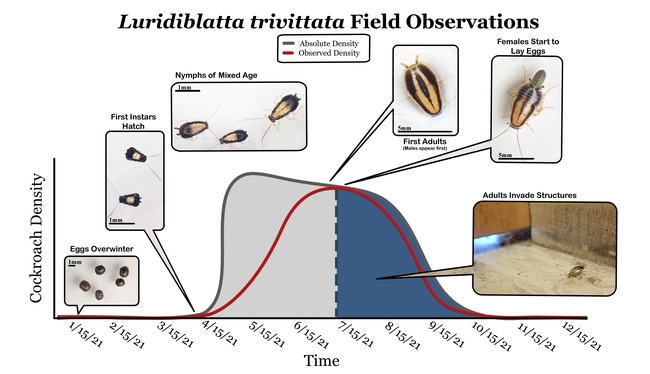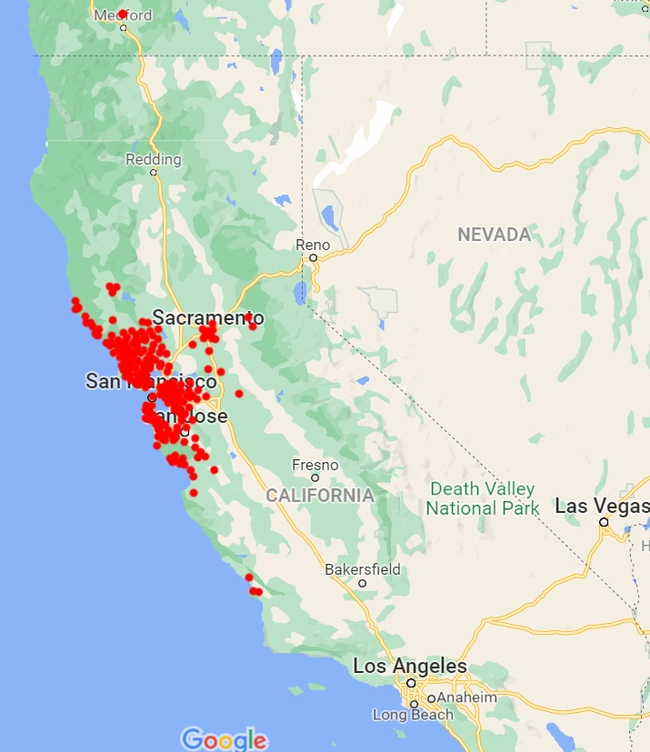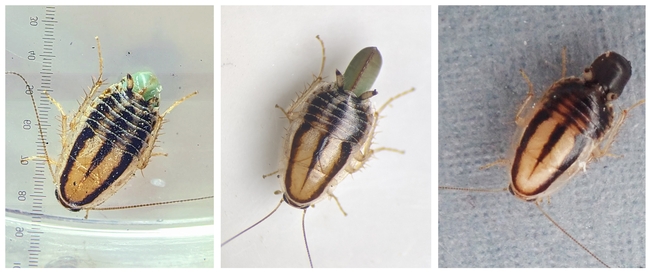[Originally published in the Summer 2022 issue of the UC IPM Green Bulletin]
The three-lined cockroach, Luridiblatta trivittata, (Figure 1) is the smallest cockroach species in California, with adults averaging only 5–7 mm in length. This newly introduced cockroach is native to North Africa and the Eastern Mediterranean. It was first detected in California around 2004 in Marin County, but it was not positively identified until 2009. Since then the three-lined cockroachhas slowly expanded its range to include the entire San Francisco Bay Area, south to San Luis Obispo, east to the foothills of El Dorado County, and north to Mendocino County.
 Fig. 1. Three-lined cockroaches. [Credit: Casey Hubble, UCCE]
Fig. 1. Three-lined cockroaches. [Credit: Casey Hubble, UCCE]

Life cycle and biology
The three-lined cockroach lives in some of the most densely populated parts of northern California, but it's not a domestic pest species since it is rarely found indoors. Instead, these cockroaches prefer to live outdoors in natural or ornamental landscapes and can be found in matted thatch, compost bins, and leaf litter. Occasionally in late summer and early fall, adults will wander indoors through poorly sealed exterior doors and windows.
When inside, they are often misidentified as German cockroach nymphs (Blattella germanica), sometimes leading to unnecessary indoor insecticide applications. However, the number of stripes on the cockroach's body can help distinguish the species. The three-lined cockroach has three distinct stripes that run down the length of the adult's body, while German cockroach adults and nymphs have only two stripes (Figure 2).

It is unclear what the three-lined cockroach likes to eat in the landscape. Within the San Francisco Bay Area, this species has been observed feeding on the juices from overripe fruit in trees, and various food scraps from compost bins. Though these food items may be delicious treats for the cockroaches, they would appear to be atypical meals, since large populations of this insect have been found far from fruit or human food resources. Though scant, existing scientific literature classifies them as detritivores (organisms that feed on decaying organic material, especially plant matter), but it is unclear exactly what kinds of detritus might be preferred. Unfortunately, this question remains a mystery, since insect field diets can be notoriously difficult to determine.
Virtually no research has been conducted on this species, even in its native range. To better understand the biology and ecology of L. trivittata in California, the SF Bay Area Urban IPM Team launched a field study and several lab studies in 2021, revealing some interesting observations:
- Three-lined cockroaches have only one generation per year (Figure 3).
- Juveniles hatch in mid-April and develop through spring and early summer, eventually maturing into adults during July and August.
- Once mature, females lay egg cases (called oothecae) that will overwinter until next spring. Oothecae start out mint green in color, and as they develop, turn from olive green to dark brown before they are deposited into the landscape (Figure 4).

Mediterranean climates with long dry summers and short wet winters, found in California as well as their native habitat, seem to be ideal for this species. Juveniles do not seem able to hatch from their oothecae without some spring precipitation. On the other hand, too much water throughout the overwintering cycle may cause the eggs to mold, killing the nymphs before they can hatch. Females lay on average two or three oothecae per year. Each ootheca is very small (2 mm in length) and contains about 10 tiny cockroaches on average. This number is smaller than that observed for other outdoor cockroach species in California, where most average between 11-21 nymphs per ootheca.
The common name “three-lined cockroach” was suggested by the SF Bay Area Urban IPM team and officially adopted by the Entomological Society of America. This name is not only an accurate description of the insect's appearance but is also reflected in the scientific name Luridiblatta trivittata.
What can you do?
Proper identification is crucial to providing effective pest control services. While the three-lined cockroach prefers to live outside (only occasionally wandering indoors), the German cockroach lives exclusively indoors and is considered a major public health pest. Signs of the three-lined cockroach indoors may signal the need for better structural exclusion while German cockroach infestations will need immediate remediation. If you are unsure of the pest species, contact your county's UC Cooperative Extension office, Department of Agriculture, or Vector Control District for confirmation.
Though the three-lined cockroach may be considered a nuisance pest when found in large numbers, it may not ever call for control measures. There are many unknowns remaining about this species, such as how far it may expand throughout California and neighboring states. To help us track the spread of the three-lined cockroach, you can submit photos and report sightings to iNaturalist (https://www.inaturalist.org/) or BugGuide (https://bugguide.net/node/view/15740); these civic science data can be pooled to create distribution maps (Figure 5).

This research was funded by the California Department of Pesticide Regulation.
References:
California Plant Pest & Disease Report Vol. 25. 2009. CDFA
Sutherland AM, Choe D-H, Rust MK. 2019. UC IPM Pest Notes: Cockroaches. UC ANR Publication 7467. Oakland, CA.
Djernæs, Marie, et al. "Phylogeny and life history evolution of Blaberoidea (Blattodea)." Arthropod Systematics & Phylogeny 78.1 (2020): 29-67.
